Technology explained: inside the Exynos 7 Octa 7420, Samsung's best chipset yet
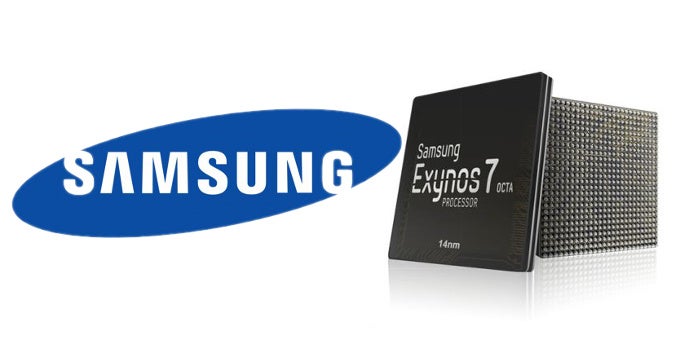
At this point, there's no doubt that the Exynos 7420 chip is a silicon beast that seems to go through benchmarks like hot knife through butter, leaving almost all of its chipset rivals behind. Indeed, Samsung has a winner in the shape of its first 14nm FinFET chipset, but what makes this vital hardware component that noteworthy? What's more important, does it have what it takes to stand the test of time and rival the upcoming chipsets of the major chip makers?
The CPU
Officially rolling under the Exynos 7 Octa 7420 name, Samsung's most advanced chip yet is shaping up to be a real powerhouse. Clicking and ticking inside the chipset is an octa-core 64-bit central processing unit that is swearing by the ARMv8 instruction set. It flaunts four Cortex-A57 cores that can go all the way up to 2.1GHz and another four Cortex-A53 ones that are clocked up to 1.5GHz. All of them sing in accordance to ARM's big.LITTLE architecture with GTS (Global Task Scheduling / Heterogeneous Multi-Processing), which dynamically switches between the two clusters of the processor cores in accordance to the intensity of the task that is at hand.
But there's something way more compelling and noteworthy about Samsung's Exynos 7420 SoC – its manufacturing process. The true highlight of the silicon chip and most probably the reason for its foreseeable superiority is the 14nm FinFET LPE (Low Power Enhanced) process that has been used for the powerful Exynos.
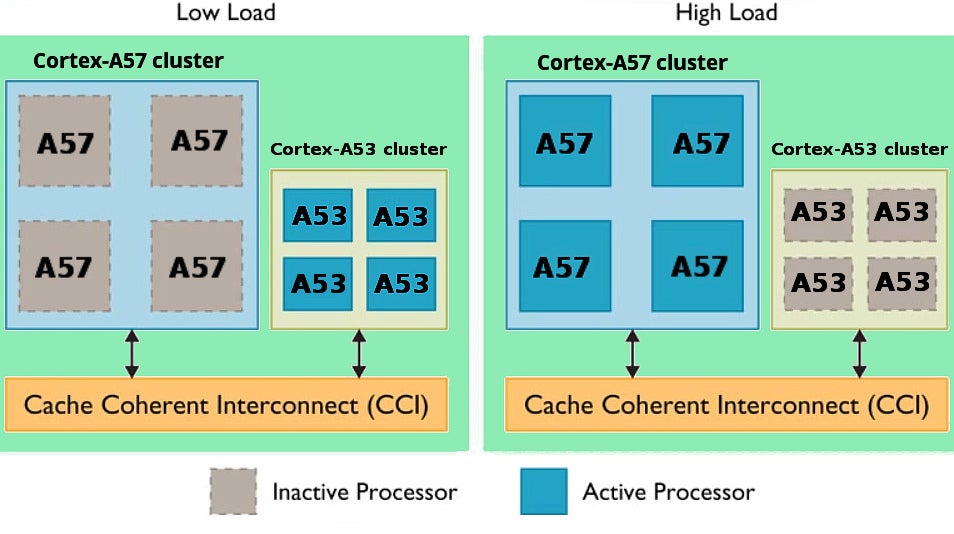
In the ultra-miniature land of chipset transistors, "the smaller, the better" is an often-recurring mantra. That's why the 14nm FinFET technology that Samsung has collaborated with Global Foundries on is vastly superior to “larger” manufacturing processes, like 16nm, 20nm, or higher. In particular, Samsung said that the Exynos 7420 is 30 to 35% more energy-efficient than its previous 20nm chips, while bringing up to 20% better performance and 30% productivity spike, all at the same time. A win-win situation, isn't it?
So far, so good, but what does FinFET mean and why is it that important? Since the dawn of the semiconductor industry, manufacturers have aimed to pack as many transistors as possible inside the processor. The rate of this increase was so fast that in 1970 Gordon E. Moore came up with his legendary law, which states that "processor speeds, or overall processing power for computers will double every two years". Packing more and more transistors inside the CPU is one of the ways to do this.
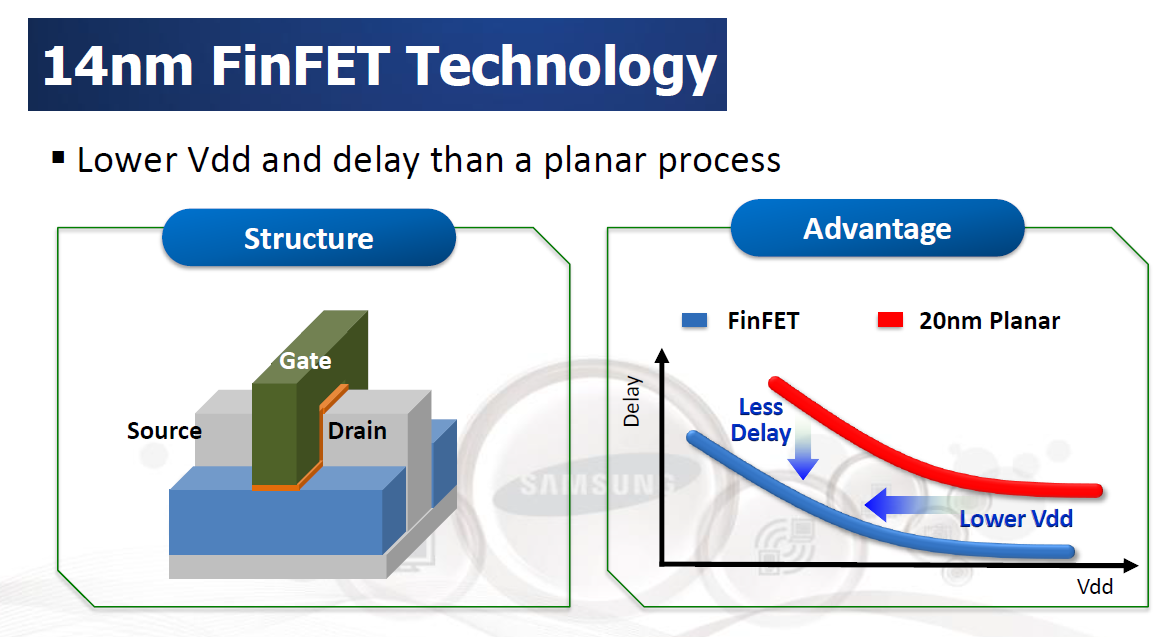
However, as transistors become smaller and smaller, the risk of current leakage and other undesired issues to occur becomes bigger. This problem is one of the main problems that endangers the evolution of regular, planar semiconductors. Fortunately, the relatively-new FinFET technology circumvents the short-channel effect drawbacks and current leakage thanks to its fin-like architecture design. FinFET does not only allow manufacturers to go below 14nm (thus bringing better performance and lower energy consumption), it also makes sure that Moore's Law will continue to be valid. For the time being.
This is among the main reasons for the performance improvement that the Exynos 7420 chip We've already had the chance to run some benchmarks on the Galaxy S6/S6 edge at MWC and see how the Exynos 7420 chip fares against its rivals. Have in mind that these are taken from pre-release units and do not necessarily show us the real deal. Therefore, take them with a grain of salt.
The GPU

Unlike the latter, which has a maximum clock speed of 700MHz, the Exynos 7420's Mali GPU unit can go all the way up to 772MHz, which should provide a rather big improvement in terms of performance in comparison with the Mali T-760 MP6 GPU that powers the Samsung Galaxy Note 4.It's certainly not the most impressive GPU in a mobile device, but those using their phones for games should be more than satisfied with the new Mali.
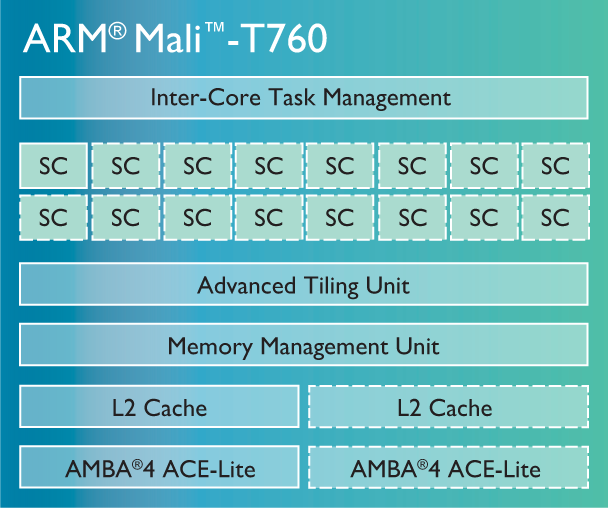
Another one, Smart Composition, further helps by reducing texture bandwidth by roughly 50% as well. Needless to say, the GPU is compatible with a handful of graphics-oriented APIs, like OpenGL ES 3.1/3.0/2.0, Open CL 1.1, as well as Direct3D 11.1, among others.
All of these improvements have allowed the GPU to get under-volted by 200mV to 300mV at the secondary maximum state, 700MHz. At the maximum clock rate, 772MHz, the GPU receives 825mV. On paper, just as we mentioned above, it seems that the Mali-T760 MP8 is a pretty substantial improvement over its MP6 cousin that crunches graphics in the Note 4/Note Edge.
Take a look at some preliminary benchmarks that show us how the Galaxy S6/S6 edge fare against their rivals.
Take a look at some preliminary benchmarks that show us how the Galaxy S6/S6 edge fare against their rivals.
Exynos 7420 chip and battery life
We are yet to put the Galaxy S6/S6 edge to the test and see how they'll fare battery-wise, yet we are expecting the new flagships to surprise us. Why? Well, if you've read the paragraphs above, you've probably noticed that we used "power-efficient" a lot. Indeed, apart from the head-turning performance, the Exynos 7420 is aiming to be as energy-efficient as it gets - starting from the CPU of the SoC and moving on to the GPU, everything seems to be tailored with efficiency in mind, not to mention Samsung's extremely battery-friendly UFS 2.0 flash memory standard that we've already told you about.
Below, you'd find a comparative table between the battery life estimates of the Galaxy S6 and the iPhone 6/6 Plus, as per the respective manufacturers.
| Wi-Fi browsing | LTE browsing | Video playback | Music playback | |
| Samsung Galaxy S6 | 12 | 11 | 13 | 49 |
| Apple iPhone 6 | 11 | 10 | 11 | 50 |
| Apple iPhone 6 Plus | 12 | 12 | 14 | 80 |
All things considered, we are quite curious to see whether the Galaxy S6 and S6 edge will live up to the expectations. As a refresher, the Samsung Galaxy S5 had a 2,800mAh powerbank at the rear, which lasted it for 7 hours and 38 minutes in our battery benchmark test. The Galaxy S6, on the other hand, has a 2,550mAh battery at the back (the S6 edge has a marginally bigger, 2,600mAh one) - how long will it keep the lights on? Only time will tell.
Follow us on Google News












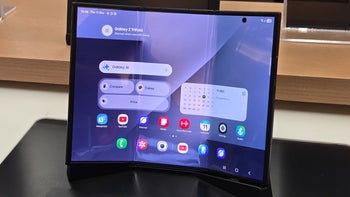
Things that are NOT allowed:
To help keep our community safe and free from spam, we apply temporary limits to newly created accounts: